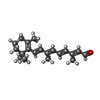+ Open data
Open data
- Basic information
Basic information
| Entry | Database: PDB / ID: 7b03 | ||||||
|---|---|---|---|---|---|---|---|
| Title | Cryo-EM structure of the green-light absorbing proteorhodopsin | ||||||
 Components Components | Proteorhodopsin | ||||||
 Keywords Keywords | PROTON TRANSPORT / Light-driven proton pump / microbial rhodopsin / retinal | ||||||
| Function / homology |  Function and homology information Function and homology informationlight-activated monoatomic ion channel activity / photoreceptor activity / phototransduction / plasma membrane Similarity search - Function | ||||||
| Biological species |  uncultured Gammaproteobacteria bacterium (environmental samples) uncultured Gammaproteobacteria bacterium (environmental samples) | ||||||
| Method | ELECTRON MICROSCOPY / single particle reconstruction / cryo EM / Resolution: 2.93 Å | ||||||
 Authors Authors | Hirschi, S. / Kalbermatter, D. / Fotiadis, D. | ||||||
| Funding support |  Switzerland, 1items Switzerland, 1items
| ||||||
 Citation Citation |  Journal: Nat Commun / Year: 2021 Journal: Nat Commun / Year: 2021Title: Cryo-EM structure and dynamics of the green-light absorbing proteorhodopsin. Authors: Stephan Hirschi / David Kalbermatter / Zöhre Ucurum / Thomas Lemmin / Dimitrios Fotiadis /  Abstract: The green-light absorbing proteorhodopsin (GPR) is the archetype of bacterial light-driven proton pumps. Here, we present the 2.9 Å cryo-EM structure of pentameric GPR, resolving important ...The green-light absorbing proteorhodopsin (GPR) is the archetype of bacterial light-driven proton pumps. Here, we present the 2.9 Å cryo-EM structure of pentameric GPR, resolving important residues of the proton translocation pathway and the oligomerization interface. Superposition with the structure of a close GPR homolog and molecular dynamics simulations reveal conformational variations, which regulate the solvent access to the intra- and extracellular half channels harbouring the primary proton donor E109 and the proposed proton release group E143. We provide a mechanism for the structural rearrangements allowing hydration of the intracellular half channel, which are triggered by changing the protonation state of E109. Functional characterization of selected mutants demonstrates the importance of the molecular organization around E109 and E143 for GPR activity. Furthermore, we present evidence that helices involved in the stabilization of the protomer interfaces serve as scaffolds for facilitating the motion of the other helices. Combined with the more constrained dynamics of the pentamer compared to the monomer, these observations illustrate the previously demonstrated functional significance of GPR oligomerization. Overall, this work provides molecular insights into the structure, dynamics and function of the proteorhodopsin family that will benefit the large scientific community employing GPR as a model protein. | ||||||
| History |
|
- Structure visualization
Structure visualization
| Movie |
 Movie viewer Movie viewer |
|---|---|
| Structure viewer | Molecule:  Molmil Molmil Jmol/JSmol Jmol/JSmol |
- Downloads & links
Downloads & links
- Download
Download
| PDBx/mmCIF format |  7b03.cif.gz 7b03.cif.gz | 186.4 KB | Display |  PDBx/mmCIF format PDBx/mmCIF format |
|---|---|---|---|---|
| PDB format |  pdb7b03.ent.gz pdb7b03.ent.gz | 157.9 KB | Display |  PDB format PDB format |
| PDBx/mmJSON format |  7b03.json.gz 7b03.json.gz | Tree view |  PDBx/mmJSON format PDBx/mmJSON format | |
| Others |  Other downloads Other downloads |
-Validation report
| Summary document |  7b03_validation.pdf.gz 7b03_validation.pdf.gz | 973.3 KB | Display |  wwPDB validaton report wwPDB validaton report |
|---|---|---|---|---|
| Full document |  7b03_full_validation.pdf.gz 7b03_full_validation.pdf.gz | 988.8 KB | Display | |
| Data in XML |  7b03_validation.xml.gz 7b03_validation.xml.gz | 33.5 KB | Display | |
| Data in CIF |  7b03_validation.cif.gz 7b03_validation.cif.gz | 45.2 KB | Display | |
| Arichive directory |  https://data.pdbj.org/pub/pdb/validation_reports/b0/7b03 https://data.pdbj.org/pub/pdb/validation_reports/b0/7b03 ftp://data.pdbj.org/pub/pdb/validation_reports/b0/7b03 ftp://data.pdbj.org/pub/pdb/validation_reports/b0/7b03 | HTTPS FTP |
-Related structure data
| Related structure data |  11955MC M: map data used to model this data C: citing same article ( |
|---|---|
| Similar structure data |
- Links
Links
- Assembly
Assembly
| Deposited unit | 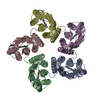
|
|---|---|
| 1 |
|
- Components
Components
| #1: Protein | Mass: 25611.842 Da / Num. of mol.: 5 Source method: isolated from a genetically manipulated source Details: Expressed without signal sequence. Source: (gene. exp.)  uncultured Gammaproteobacteria bacterium (environmental samples) uncultured Gammaproteobacteria bacterium (environmental samples)Production host:  #2: Chemical | ChemComp-RET / Has ligand of interest | Y | |
|---|
-Experimental details
-Experiment
| Experiment | Method: ELECTRON MICROSCOPY |
|---|---|
| EM experiment | Aggregation state: PARTICLE / 3D reconstruction method: single particle reconstruction |
- Sample preparation
Sample preparation
| Component | Name: Pentamer of the green-light absorbing proteorhodopsin / Type: COMPLEX / Entity ID: #1 / Source: RECOMBINANT |
|---|---|
| Molecular weight | Experimental value: NO |
| Source (natural) | Organism:  uncultured Gammaproteobacteria bacterium (environmental samples) uncultured Gammaproteobacteria bacterium (environmental samples) |
| Source (recombinant) | Organism:  |
| Buffer solution | pH: 7.5 |
| Specimen | Conc.: 3.5 mg/ml / Embedding applied: NO / Shadowing applied: NO / Staining applied: NO / Vitrification applied: YES |
| Specimen support | Grid material: COPPER / Grid type: Quantifoil R1.2/1.3 |
| Vitrification | Instrument: FEI VITROBOT MARK IV / Cryogen name: ETHANE / Humidity: 100 % / Chamber temperature: 277 K |
- Electron microscopy imaging
Electron microscopy imaging
| Experimental equipment |  Model: Titan Krios / Image courtesy: FEI Company |
|---|---|
| Microscopy | Model: FEI TITAN KRIOS |
| Electron gun | Electron source:  FIELD EMISSION GUN / Accelerating voltage: 300 kV / Illumination mode: SPOT SCAN FIELD EMISSION GUN / Accelerating voltage: 300 kV / Illumination mode: SPOT SCAN |
| Electron lens | Mode: BRIGHT FIELD |
| Image recording | Electron dose: 1.36 e/Å2 / Film or detector model: GATAN K3 (6k x 4k) |
- Processing
Processing
| EM software |
| ||||||||||||||||||||||||
|---|---|---|---|---|---|---|---|---|---|---|---|---|---|---|---|---|---|---|---|---|---|---|---|---|---|
| CTF correction | Type: PHASE FLIPPING AND AMPLITUDE CORRECTION | ||||||||||||||||||||||||
| Symmetry | Point symmetry: C5 (5 fold cyclic) | ||||||||||||||||||||||||
| 3D reconstruction | Resolution: 2.93 Å / Resolution method: FSC 0.143 CUT-OFF / Num. of particles: 717107 Details: Final map was obtained after applying density modification using Resolve Cryo-EM in Phenix. Symmetry type: POINT |
 Movie
Movie Controller
Controller



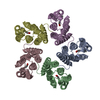
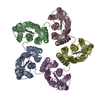
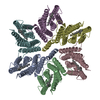
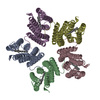
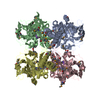
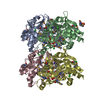




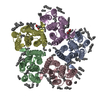
 PDBj
PDBj





